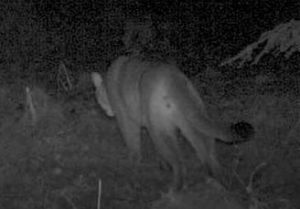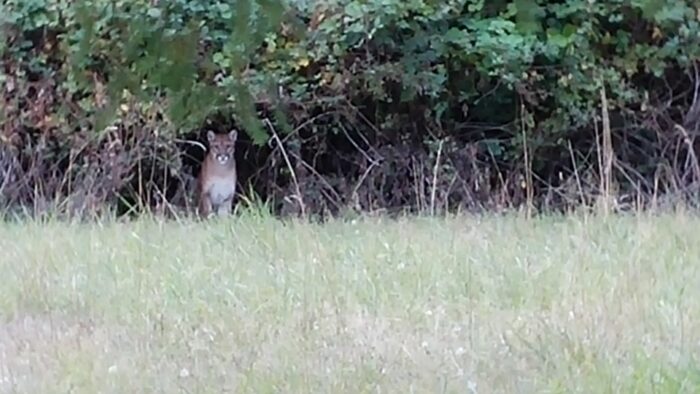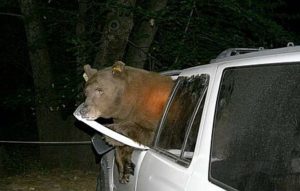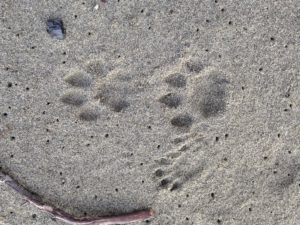by Bianca Perla
As I left the wilderness and drove back into cell service my phone exploded with texts. The cougar had been killed. Both kids and adults cried at the news, wondering why. Many in our community disagreed about this cougar but most people seemed to agree on one thing, they did not want this cougar’s stay to end in death and the question of why it did still lingers. Here I draw on my experience as VNC director and as an ecologist to attempt to shed light on why.
We live in a pivotal time of change in large carnivore management. For the past 50 years management has been heavily focused on predator control. Because of this we’ve discovered what happens in areas where predators are absent. Consequently, the books of predator ecology and human-wildlife conflict are being re-written. Yet many management frameworks, societal values and public opinions have yet to reflect this.
In the 1990’s, I helped run howling surveys for wolves in the Frank Church River of No Return Wilderness, a wolf reintroduction effort concurrent with Yellowstone. Through tracking the effect of these reintroduction programs, we’ve learned that top predators can have trickle down effects called “trophic cascades” that promote everything from healthy song bird populations, to diverse forest understories, to less erosive river courses that make better habitat for fish.
We’ve also learned about how traumatic relocation can be. Yellowstone developed a soft release technique that moved family units together and kept them in an enclosure for months before release into the wild. Otherwise wolves scattered from the stress and many eventually died. Wolf reintroduction has also taught us a lot about wildlife conflict and how societal attitudes about predators can sometimes be harder to change than the ecological landscapes themselves.
In the early 2000’s I worked in Yosemite right at the time when bears discovered they could open cars like a human opens a soda can—curl your paws around the top back edge of a door, peel back and pull. Pop! Treats galore. At first, problem bears were relocated. They either found their way back to the valley, or fled the release site to places no one wanted them to go. They also taught their new bear friends and families how to steal food from humans. Problem bears got three chances and then they were euthanized. Of course, bears did not know or care about this rule of 3.
Then, a light bulb went off in some wildlife biologist’s head. This is not a bear problem, this is a people problem! We need to manage people better. Bear boxes were installed in parking lots. Fines were instituted for leaving food in cars. Garbage cans were retrofitted with locks. This considerably reduced damage to cars. However, some bears persisted. It was so easy and they had become habituated. So, snipers were installed in parking lots to shoot rubber bullets at offending bears. Through this combined effort of human behavior management and aversion techniques bears learned that car theft was not profitable anymore and the cultural practice of popping open cars has been practically eliminated (reduced by 96% since 1998).
As the above story shows, we are learning that conflicts between wildlife and humans can be solved most effectively most of the time by modifying human behavior. However, for years management focus has been on eradicating or relocating “problem” animals. So, the public is usually still conditioned to expect that wildlife managers do something about the animal even if the problems originate in part from human action.
At this crossroads in wildlife management history, the Vashon cougar swam to us. He crawled out onto the shore of an island that had not experienced living with large predators for at least 3 generations. We were not prepared for the cougar. We were already reeling from having to learn about and adapt to the new coyote population, and even that was not going so great.
During my studies at Stanford University I got a rare opportunity to live on the Zuni Indian Reservation. I worked at the Zuni Conservation Project—one of the first tribally run natural resource agencies. One meeting changed my thinking about wildlife management considerably. It was a meeting between farmers and ZCP biologists. Beavers had arrived and were building dams in the same streams that Zuni farmers used to irrigate their crops. This was causing conflict especially when water levels were drawn down too low forcing beavers to abandon their dams.
The conversation started predictably blaming the damn Game and Fish commission for these damn beavers and their damn dams. I could predict the rest of the conversation: we didn’t want them here in the first place, they are inhibiting our ability to irrigate. What if they grow in population and take over all the streams? Let’s get rid of them.
But instead the conversation proceeded: well just because they weren’t here before doesn’t mean they don’t belong here now. They are raising families in this place. They are telling us it’s home. How much water do they need? How do we keep from pumping the water levels below what they need? The decision was made to raise the level of the irrigation pipes that drew from the river so that they would leave a base level of water. Then farmers would work together to help each other shift to using more drought resistant strains of corn and seasonally phased planting. This happened in one meeting. I was floored.
Back to the Vashon cougar: The officials at WDFW did not want to kill this cougar. They tried everything they could to encourage us to change our behaviors so that both the cougar and our domestic animals could be safe. They spent countless hours on the phone personally talking with residents. At VNC’s request they gave a talk to the community about how to live safely and effectively with large carnivores, participated in radio shows and newspaper interviews. They visited residences suggesting improvements when animals were killed and helped us fact check our Co-existing with Large carnivores fact sheet. They also clearly stated in their most recent interview with Vashon Nature Center’s Kathryn True (an article that ran in the Beachcomber) that euthanizing was the most likely option if this cat was caught.
Sadly, although we were in the process of making changes to adapt to this cougar’s presence, we were not quick enough in the transformation for he and us to reap the benefits. Those who did make changes, thank you. Your efforts are not in vain. Most, if not all, confirmed attacks by the cougar on Vashon were in pastures with high densities of brush, or where animals could access treed areas or were pastured in the woods. We can learn from these experiences. In the future, clearing pastures of brush, fencing animals out of woods areas, or getting animals used to night pens before an attack occurs could help us live more safely with mountain lions.
I don’t know how WDFW’s decision to euthanize was finally made. But from my best understanding based on my experience and talking with WDFW it was a decision based on quantitative information (how many kills/interactions), an analysis of alternatives (relocation liability and precedent), and qualitative experience (will people here change their behaviors to help minimize these conflicts or will these conflicts continue?) The bottom line is we can not pass all the blame to WDFW on this. Our community is also responsible for the cougar’s death.
Here’s a quick run down on why relocation isn’t as neat and tidy as it seems. Relocation is highly traumatizing to a wild animal. Often a relocated animal will bolt at release so it is hard to predict where they will end up. Furthermore, a young male cougar like ours would likely run to the safest place, another urban fringe, to get out of the danger zone of grown male cougars unless he feels brave enough to fight to the death.
Out of curiosity, I looked up how many cougars are killed each year due to problems or conflicts with humans, pets, and livestock. I could find no clear numbers for Washington state (although I learned we have about 2100 cougars). I did find the statistics for Oregon. Oregon Fish and Wildlife, over a ten-year period from 2004-2014 euthanized an average of 180 cougars per year to manage wildlife conflict in Oregon. If you want to pick relocation over euthanizing where do you draw the line? That is a lot of cougars to relocate and there are not enough zoos or wildlife havens in the world to take that many.
Considering this and the fact we still have coyotes, possibly a bear, and at some low tide in the future another mountain lion it makes the most sense to try harder to make changes in our techniques and behaviors. We can be innovative, work together to protect livestock and pets, and put social structures in place that support those who find it hard to do this. We can also lobby our political leaders to allow wildlife managers like WDFW to use our tax dollars to assist landowners in implementing tools for conflict prevention.
Ultimately, a road map for living with wildlife is something the community needs to decide on together. How this will be done in the absence of a community council or any other governing body that can make these decisions is a mystery to me. But, if we work towards adapting to rather than resisting our wildlife we can create a future on Vashon where we don’t have to choose between the safety of our domestic animals and the lives of wild ones. No technique (lethal control, relocation, modifying human behavior) is fool-proof and pet owners and livestock owners cannot be expected to be perfect 100% of the time but we can minimize conflicts considerably. A few changes now will lead to many benefits down the road for our peace of mind, for our conscience, and for our quality of life.
An active livestock management guide, a collaborative effort between VNC scientists, wildlife experts and farmers is currently going through review and due out in September. This will help with wildlife protection practices for coyotes, cougars and bears. Stay tuned.

RIP Vashon cougar. Your presence taught so many of us so much. We will always remember you. photo: Bianca Perla, by wildcam.
Note: Links point to original sources and scientific papers. Featured photo by: Jesse Bell




Thank you. I found your perspective to be very informative. Ever sinc the cougar was put down I have felt an emptiness on Vashon. I know that those who lost animals/pets feel the same emptiness . I hope that we can someday learn how to live with nature.
Very well said Joyce. Thank you.
It is so sad that pets were lost and now the cougar. I was hoping he would leave before pet owners and or fearful residents decided to take action. I really do have sympathy for the folks who lost their pets and livestock, having lost a dog myself to coyotes in Ca… It’s been interesting to listen to long time residents of the Lake Tahoe area, where I’ve recently moved, discuss bears. Bear boxes for garbage are everywhere. All new homes must have bear boxes. Sightings are frequent but due to careful garbage management there are very few problems. The discussion at garden club turned to recent bear sightings One bear was seen recently in a backyard pond…A female has been seen many springs with cubs near local Tahoe City tennis courts. No one seemed too alarmed. Residents here seem to have accepted the reality and done what is necessary to coexist. I hope the same can happen on Vashon. I know I will never again leave a dog or cat outside alone where there are coyotes.
Thanks for the perspective Susie. It is important to share stories of other communities that are successful living with wildlife as it shows that it is possible.
Thanks for this, Bianca. It is heartfelt, informative and well written.
To clarify, we have lived with large predatory animals here and commonly, for the last three generations. Consider and compare the danger to humans – bear versus cat. By nature, cats elude. Bear “bump into.”
I suggest that a history of predatory animals on Vashon Island, rather than WDFW would be far more accurate coming from our Sportsman’s Club. Whether the history has been handed down as narrative or their meeting minutes, this history has been carried by locals, for close to 100 years.
It is important to understand, it’s local hunters – who pay the tab to do so – that collect and report numbers and movement of wild animals in WA State to WDFW. The latter, compile the hunters’ data.
Also, I am saddened that although it has been posted and reposted, there has been so little comment regarding the New Yorker article, “Lions of Los Angeles.” It’s an eloquent story of living with these cats in an urban area. Timely and well worth the read.
Thanks, again, Bianca.
Great suggestions Dona. I would love to talk with Sportsmen about the history of predators here. In my understanding none have stayed this long for awhile but it would be great to flush out the natural history better, that’s one of the goals we have here at VNC. Thanks for referencing the Lions of Los Angeles article as well. Great one.
Vashon killed it’s one and only cougar.
I am disappointed, disheartened, and disillusioned about our Vashon community. I had believed this was a special place in which the people treasured Vachon’s unique natural environment in such close proximity to the city and suburbs. Noop- rather than taking responsibility for their pets, people on Vashon believe their pets are more justified in enjoying unsupervised play outside than a natural inhabitant – a cougar. Apparently, Vashon is just another Seattle suburb. Might as well invite Walmart, MacDonald’s, Costco, and a bunch of high rises to move to Vashon.
I just am blown away at this post. Thank you so much for your professionalism, intelligent fact filled conversation. Thank you for being here, and I look forward to learning so much more about our habitat here on Vashon through your guidance.
Thanks for the kind words John.
Thank you for this great explanation! It illustrates how hard it was to save this animal and that so much was done to try. I have had experience with domestic animals being killed by predators and have mourned for them. My daughter lives on Vashon, I visit often.
Bianca, thank you so much for your thoughtful, accurate, and informative piece. An excellent summary of the situation. I feel as though we have failed as a community. We need to keep education going so when the next cougar arrives people will be more prepared.
Thank you Sheila, I agree.
While I too would have preferred relocation of the animal to killing it…i understand that it had become a nuisance animal…preying on goats and cats and other domesticated animals. Once an animal develops a taste for that its hard to deter them from encroaching on another human habitat and causing more destruction.
All mountain lions, really all the large carnivores that come to Vashon (bears, coyotes too) are opportunistic and will take what is easiest to catch. Thus they all have the potential to become a nuisance to us if we let them. An ounce of prevention is worth a pound of cure applies very strongly to living with wildlife. If we work as a community to keep our pets and livestock hard to access from the get go this greatly eliminates conflict.
Thank you, Bianca, for your thoughtful analysis and explanation. It helps me deal with my emotions about the unfortunate end of this young cougar’s life. May we all do better next time.
Thanks Mark. I sincerely hope we can do better next time too. I am hopeful.
Thanks Bianca, for being a voice of reason and for helping to educate us all throughout this brief episode of living with a top-tier predator here on Vashon. I was sad to learn about the cougar’s end, knowing it must have been a tough call for the Fish and Wildlife folks. You’re right, we weren’t (and aren’t) fully prepared to co-exist with a cougar here on Vashon. Yet. And as the pressure of development continues to bear down on us here, we will have to bump up our efforts even more in educating people about what a healthy rural ecosystem looks like and the important roles that top predators play in this. The cougar was just trying to survive in a new territory.
Very well said Sara. I agree.